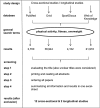The relationship between physical activity, physical fitness and overweight in adolescents: a systematic review of studies published in or after 2000
- PMID: 23375072
- PMCID: PMC3571910
- DOI: 10.1186/1471-2431-13-19
The relationship between physical activity, physical fitness and overweight in adolescents: a systematic review of studies published in or after 2000
Abstract
Background: Not only in adults but also in children and adolescents, obesity increases the risk for several health disorders. In turn, many factors including genetic variations and environmental influences (e.g. physical activity) increase the risk of obesity. For instance, 25 to 40 percent of people inherit a predisposition for a high body mass index (BMI). The purpose of this systematic review was to summarize current cross-sectional and longitudinal studies on physical activity, fitness and overweight in adolescents and to identify mediator and moderator effects by evaluating the interaction between these three parameters.
Methods: The electronic academic databases PubMed, SportDiscus, WEB OF KNOWLEDGE and Ovid were searched for studies on physical activity, fitness and overweight in adolescents aged 11 to 19 years (cross-sectional studies) and in adolescents up to 23 years old (longitudinal studies) published in English in or after 2000.
Results: Twelve cross-sectional and two longitudinal studies were included. Only four studies analyzed the interaction among physical activity, fitness and overweight in adolescents and reported inconsistent results. All other studies analyzed the relationship between either physical activity and overweight, or between fitness and overweight. Overweight--here including obesity--was inversely related to physical activity. Similarly, all studies reported inverse relations between physical fitness and overweight. Mediator and moderator effects were detected in the interrelationship of BMI, fitness and physical activity. Overall, a distinction of excessive body weight as cause or effect of low levels of physical activity and fitness is lacking.
Conclusions: The small number of studies on the interrelationship of BMI, fitness and physical activity emphasizes the need for longitudinal studies that would reveal 1) the causality between physical activity and overweight / fitness and overweight and 2) the causal interrelationships among overweight, physical activity and fitness. These results must be carefully interpreted given the lack of distinction between self-reported and objective physical activity and that studies analyzing the metabolic syndrome or cardiovascular disease were not considered. The importance of physical activity or fitness in predicting overweight remains unknown.
Figures
References
-
- World Health Organisation: Obesity. preventing and managing the global epidemic. Report of a WHO consultation. World Health Organ Tech Rep Ser. 2000;894:1–253. - PubMed
-
- Wang Y, Lobstein T. Worldwide trends in childhood overweight and obesity. IJPO. 2006;1(1):11–25. - PubMed
-
- Prevalence of Obesity Among Children and Adolescents: United States, Trends 1963–1965 trough 2007–2008. http://www.cdc.gov/nchs/data/hestat/obesity_child_07_08/obesity_child_07....
Publication types
MeSH terms
LinkOut - more resources
Full Text Sources
Other Literature Sources
Medical
Research Materials


